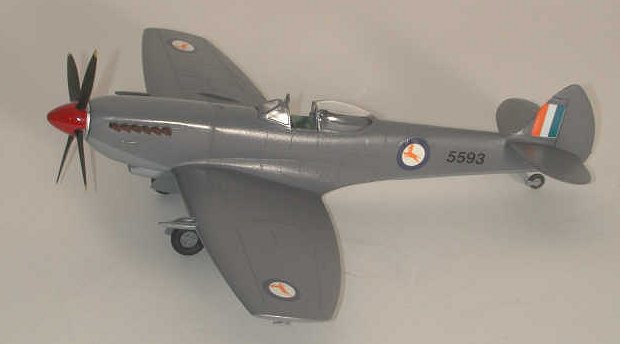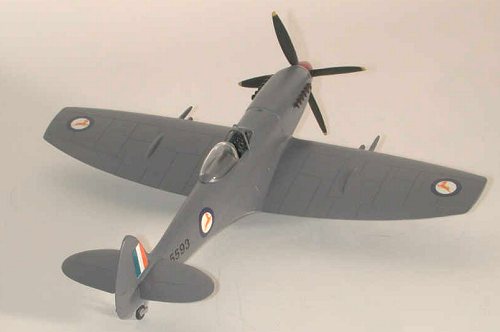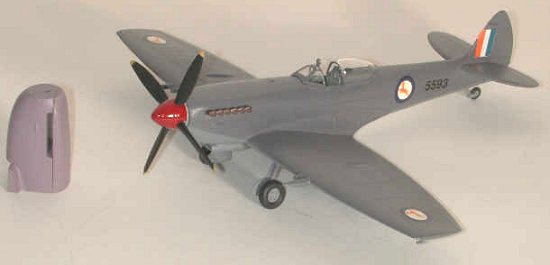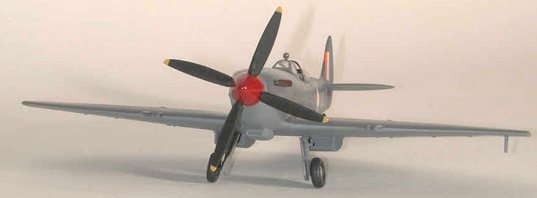
Ocidental 1/48 Spitfire XVI
|
KIT # |
? |
|
PRICE: |
$30.00 |
|
DECALS: |
Roundels and serial – generic SAAF Decals sheet. Fin Flash from Dutch Decals SAAF sheet: all available from Flightdecs. |
|
REVIEW & |
Sinuhe Hahn & Piet van Schalkwyk |
|
NOTES: |
Aeroclub nose correction used. |

|
HISTORY |
 Following
cessation of hostilities, it was natural that the SAAF (South African Air force)
would continue operating Spitfires in one form another, as during WW2, ten SAAF
squadrons had flown Spitfires. The first unit to convert to Spitfires MkVb’s was
1 Squadron in November 1942, who had previously been flying Hurricanes. The next
was 40 Squadron, who operated their MkVb’s in a tactical reconnaissance role,
using an oblique camera installed behind the cockpit. These are probably the
best known of all SAAF Spitfires, since several colour photos exist, which
proudly display their red/white WR Squadron codes, yellow leading edges and SAAF
roundels complete with orange centers. 2 Squadron, “The Flying Cheetahs” is also
well known for the use of its four cannon equipped MkVC’s.
Following
cessation of hostilities, it was natural that the SAAF (South African Air force)
would continue operating Spitfires in one form another, as during WW2, ten SAAF
squadrons had flown Spitfires. The first unit to convert to Spitfires MkVb’s was
1 Squadron in November 1942, who had previously been flying Hurricanes. The next
was 40 Squadron, who operated their MkVb’s in a tactical reconnaissance role,
using an oblique camera installed behind the cockpit. These are probably the
best known of all SAAF Spitfires, since several colour photos exist, which
proudly display their red/white WR Squadron codes, yellow leading edges and SAAF
roundels complete with orange centers. 2 Squadron, “The Flying Cheetahs” is also
well known for the use of its four cannon equipped MkVC’s.
The post war SAAF ordered 136 Spitfire Mk IX’s, which were delivered from 1947 onwards. It is not clear why the SAAF ordered Merlin engined Spitfires, unlike the Rhodesian Air force which ordered more modern Griffon engined variants. The aircraft allocated to Nos 1, 2 4 and 60 Squadrons as well as the bombing, Gunnery and navigation school. No. 60 Sqn used their Spitfires in a reconnaissance capacity, having an oblique camera installed behind the cockpit and 2 vertical cameras in the fuselage. Equiped with rocket rails and bomb racks, the Spitfires played an important role in familiarising pilots with these weapons prior to their departure for the war in Korea. In 1954 the last of the Spitfires were withdrawn from service in the SAAF.
|
THE KIT |
This model was built prior to the release of the MkXVI kit by ICM. Forewarned about problems with the shape of the Occidental kit nose, I ordered the kit together with a correction kit from Aeroclub. This Occidental kit was released as a limited edition kit, without decals, with a striking image on the box cover. In general fit was very good, and I found the cockpit detail to be adequate. In fact the breakdown of the cockpit was very similar to the Tamiya MkV, which I prefer to the Hasegawa MkV one.
|
CONSTRUCTION |
 The erroneous nose was removed with a razor saw, and the
Aeroclub nose was fitted in its place. Care had to be
taken to match this new nose correctly to the kit, as it is slightly wider than
the kit fuselage – it is unclear if this is due to the slightly narrow fuselage
of the Ocidental kit many reviewers have commented upon. The only other error
which needed to be corrected were the canon covers, as those for a “C” are
supplied, whereas most late MkIX’s were of the “e” type.
The erroneous nose was removed with a razor saw, and the
Aeroclub nose was fitted in its place. Care had to be
taken to match this new nose correctly to the kit, as it is slightly wider than
the kit fuselage – it is unclear if this is due to the slightly narrow fuselage
of the Ocidental kit many reviewers have commented upon. The only other error
which needed to be corrected were the canon covers, as those for a “C” are
supplied, whereas most late MkIX’s were of the “e” type.
|
PAINT & DECALS |
During the last period of their service in the SAAF, Spitfires were painted in an attractive scheme of Extra Dark Sea Grey top surfaces and Medium Sea Grey undersides. Gunze acrylics were used for both colours. In my opinion, these paints are simply wonderful, and I wish I could achieve the same fine finish with other acrylic paints. Tamiya tape was used for the masking. The tires were sprayed in Gunze Flat Tire Black. A few coats of Future (imported from the US: thank you Vivian) were applied to the model prior to application of the decals.
 Initially I intended to use the recently released set of SAAF
decals from Dutch Decals. Research, however, indicated that the Spitfire they
had depicted was not a square tipped clipped wing MkIX, but the usual oval full
span wing version. For this reason I chose another subject, No. 5593, the last
Spitfire to fly in SAAF service. This Spitfire was finally stationed at Port
Elizabeth where it served as an instructional frame, following which it was
stripped and scrapped in 1955. Only upon completion did I realise that 5593 did
not have a red propeller spinner, but a dark blue one (why does this happen once
you have finished everything..?). This would indicate that 5593 had previously
served with 1 Sqn, and not with 2 Sqn, as the latter had red spinners, whereas
those of 60 Sqn. had white spinners.
Initially I intended to use the recently released set of SAAF
decals from Dutch Decals. Research, however, indicated that the Spitfire they
had depicted was not a square tipped clipped wing MkIX, but the usual oval full
span wing version. For this reason I chose another subject, No. 5593, the last
Spitfire to fly in SAAF service. This Spitfire was finally stationed at Port
Elizabeth where it served as an instructional frame, following which it was
stripped and scrapped in 1955. Only upon completion did I realise that 5593 did
not have a red propeller spinner, but a dark blue one (why does this happen once
you have finished everything..?). This would indicate that 5593 had previously
served with 1 Sqn, and not with 2 Sqn, as the latter had red spinners, whereas
those of 60 Sqn. had white spinners.
National markings and serial numbers were used form the generic SAAF sheet produced by Ken Smy and Modeldecal, as these are very accurate for this period of SAAF aircraft. All markings were dipped in a drop of Future prior to application. Once dry the model was given a few more brief coat to seal the decals. No attempt at weathering was taken, although in reflection, this model would profit from it, as it just appears too clean in its smart grey outfit.
|
CONCLUSIONS |
This has been a fun build and completed very rapidly, without having to resort to tons of putty and meters of sandpaper, and makes a nice addition to my SAAF collection. Should anyone express in the future release of SAAF markings, please contact us at: Springbokdecals@yahoo.co.uk
If you would like your product reviewed fairly and quickly by a site that has thousands of visits a day, please contact me or see other details in the Note to Contributors.